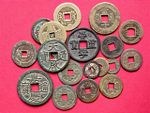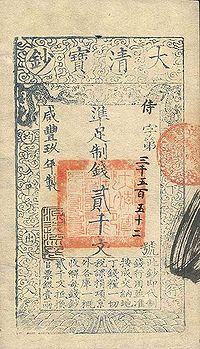
Chinese wen
Encyclopedia

Denomination (currency)
Denomination is a proper description of a currency amount, usually for coins or banknotes. Denominations may also be used with other means of payment like gift cards. See also Redenomination.-Subunit and super unit:...
used in China
China
Chinese civilization may refer to:* China for more general discussion of the country.* Chinese culture* Greater China, the transnational community of ethnic Chinese.* History of China* Sinosphere, the area historically affected by Chinese culture...
between 621 and 1948. It was the chief denomination until the introduction of the yuan
Chinese yuan
The yuan is the base unit of a number of modern Chinese currencies. The yuan is the primary unit of account of the Renminbi.A yuán is also known colloquially as a kuài . One yuán is divided into 10 jiǎo or colloquially máo...
in the late 19th century.
Etymology
The English term "cash" was first used on coins issued in Kwangtung (Guangdong) Province in 1900. It did not appear on paper money. This name was derived from the TamilTamil language
Tamil is a Dravidian language spoken predominantly by Tamil people of the Indian subcontinent. It has official status in the Indian state of Tamil Nadu and in the Indian union territory of Pondicherry. Tamil is also an official language of Sri Lanka and Singapore...
kāsu, a South India
South India
South India is the area encompassing India's states of Andhra Pradesh, Karnataka, Kerala and Tamil Nadu as well as the union territories of Lakshadweep and Pondicherry, occupying 19.31% of India's area...
n monetary unit. The plural
Plural
In linguistics, plurality or [a] plural is a concept of quantity representing a value of more-than-one. Typically applied to nouns, a plural word or marker is used to distinguish a value other than the default quantity of a noun, which is typically one...
forms "cash" and "cashes" were both used. The English word "cash", meaning "tangible currency", is an older word from Middle French
Middle French
Middle French is a historical division of the French language that covers the period from 1340 to 1611. It is a period of transition during which:...
caisse.. The Chinese character 文 (pinyin: wén) has several other meanings in modern Chinese. http://www.mandarintools.com/cgi-bin/wordlook.pl?word=%E6%96%87&searchtype=chinese&where=whole&audio=on
History
The wén was introduced as a denomination used on cast coins in 621. It became one of the chief units of currency and was used to denominate both coins and paper money. Other denominations were used, including various weights, based on the taelTael
Tael can refer to any one of several weight measures of the Far East. Most commonly, it refers to the Chinese tael, a part of the Chinese system of weights and currency....
system, for sycee
Sycee
A sycee was a type of silver or gold ingot currency used in China until the 20th century. The name derives from the Cantonese words meaning "fine silk"...
silver and gold ingots.
Until the 19th century, coins denominated in wén were cast, the most common formation being the round-shaped copper coin with a square or circular hole in the centre. The hole enabled the coins to be strung together to create higher denominations, as was frequently done due to the coin's low value. The number of coins in a string of cash varied over time and place but was nominally 1000. A string of 1000 wén was supposed to be equal in value to one tael
Tael
Tael can refer to any one of several weight measures of the Far East. Most commonly, it refers to the Chinese tael, a part of the Chinese system of weights and currency....
(liǎng) of pure silver
Silver
Silver is a metallic chemical element with the chemical symbol Ag and atomic number 47. A soft, white, lustrous transition metal, it has the highest electrical conductivity of any element and the highest thermal conductivity of any metal...
. Each string of cash was divided in ten sections of 100. The person who strung the cash into a string took one, two, or three cash per hundred, depending on local custom, as payment for his effort. So, in fact, an ounce of silver could vary in exchange from 970 to 990 cash (or more) between two places fairly close together.. In places in the North where there was a shortage of coinage a string of 500 or 500 exchanged for an ounce of silver. Paper money sometimes showed pictures of the appropriate number of 1 wén coins strung together.
In the 19th century, foreign coins began to circulate widely in China, particularly silver coins such as the Mexican peso
Mexican peso
The peso is the currency of Mexico. Modern peso and dollar currencies have a common origin in the 15th–19th century Spanish dollar, most continuing to use its sign, "$". The Mexican peso is the 12th most traded currency in the world, the third most traded in the Americas, and by far the most...
. In 1889, Chinese currency began to be denominated in the yuan
Chinese yuan
The yuan is the base unit of a number of modern Chinese currencies. The yuan is the primary unit of account of the Renminbi.A yuán is also known colloquially as a kuài . One yuán is divided into 10 jiǎo or colloquially máo...
and its subdivisions. The cash or wén was retained in this system as yuan. Traditional style, cast 1 wén coins continued to be produced until the end of the Chinese Empire
Late Imperial China
Late Imperial China refers to the period between the end of Mongol rule in 1368 and the establishment of the Republic of China in 1912 and includes the Ming and Qing Dynasties...
in 1911. The last coins denominated in cash were struck in the early years of the Republic of China
Republic of China
The Republic of China , commonly known as Taiwan , is a unitary sovereign state located in East Asia. Originally based in mainland China, the Republic of China currently governs the island of Taiwan , which forms over 99% of its current territory, as well as Penghu, Kinmen, Matsu and other minor...
in 1924.
Coins

Paper money

Paper Money
Paper Money is the second album by the band Montrose. It was released in 1974 and was the band's last album to feature Sammy Hagar as lead vocalist.-History:...
, issued in China between the 7th and 15th centuries, was denominated in wén. The notes carried depictions of coins, sometimes in strings of ten. The notes of the Yuan dynasty
Yuan Dynasty
The Yuan Dynasty , or Great Yuan Empire was a ruling dynasty founded by the Mongol leader Kublai Khan, who ruled most of present-day China, all of modern Mongolia and its surrounding areas, lasting officially from 1271 to 1368. It is considered both as a division of the Mongol Empire and as an...
suffered from hyperinflation
Hyperinflation
In economics, hyperinflation is inflation that is very high or out of control. While the real values of the specific economic items generally stay the same in terms of relatively stable foreign currencies, in hyperinflationary conditions the general price level within a specific economy increases...
due to over production without sufficient coins to back them and were withdrawn. Paper money reappeared in the 19th century. In 1853, notes were introduced in denominations of 500, 1000 and 2000 wén. 5000 wén notes followed in 1856, with 10,000, 50,000 and 100,000 wén notes added in 1857. The last of these notes were issued in 1859.
External influence
Early KoreaKorea
Korea ) is an East Asian geographic region that is currently divided into two separate sovereign states — North Korea and South Korea. Located on the Korean Peninsula, Korea is bordered by the People's Republic of China to the northwest, Russia to the northeast, and is separated from Japan to the...
n and Japan
Japan
Japan is an island nation in East Asia. Located in the Pacific Ocean, it lies to the east of the Sea of Japan, China, North Korea, South Korea and Russia, stretching from the Sea of Okhotsk in the north to the East China Sea and Taiwan in the south...
ese currencies, the Korean mun
Korean mun
The mun was introduced as the main currency of Korea in 1633 and stayed in use until 1892. It resembled and was derived from the Chinese wen . Coins denominated in mun were cast in copper or bronze and were round with square holes. In 1888, coins were struck in small numbers denominated in mun and...
and Japanese mon, were derived from the Chinese wén and written with the same character. In 1695, the Shogunate placed the Japanese character
Kanji
Kanji are the adopted logographic Chinese characters hanzi that are used in the modern Japanese writing system along with hiragana , katakana , Indo Arabic numerals, and the occasional use of the Latin alphabet...
gen (元) on the obverse of copper coins. Vietnam
Vietnam
Vietnam – sometimes spelled Viet Nam , officially the Socialist Republic of Vietnam – is the easternmost country on the Indochina Peninsula in Southeast Asia. It is bordered by China to the north, Laos to the northwest, Cambodia to the southwest, and the South China Sea –...
gained independence from China
China
Chinese civilization may refer to:* China for more general discussion of the country.* Chinese culture* Greater China, the transnational community of ethnic Chinese.* History of China* Sinosphere, the area historically affected by Chinese culture...
in 938 and merely carried on the tradition of using cash. The first Vietnamese cash
Vietnamese cash
Vietnamese cash is a cast round coin with a square hole. The same type of currency circulated in China, Japan and Korea for centuries.-History:The first Vietnamese coins were cast under the rule of the Đinh Dynasty ....
was issued in 968.
See also
- Japanese mon
- Korean munKorean munThe mun was introduced as the main currency of Korea in 1633 and stayed in use until 1892. It resembled and was derived from the Chinese wen . Coins denominated in mun were cast in copper or bronze and were round with square holes. In 1888, coins were struck in small numbers denominated in mun and...
- Vietnamese vanVietnamese cashVietnamese cash is a cast round coin with a square hole. The same type of currency circulated in China, Japan and Korea for centuries.-History:The first Vietnamese coins were cast under the rule of the Đinh Dynasty ....

